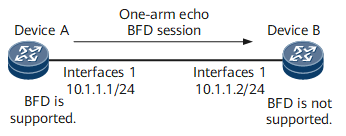Example for Configuring a One-Arm BFD Echo Session
This section provides an example for configuring a one-arm BFD echo session on a device that supports BFD.
Networking Requirements
As shown in Figure 1, Device A supports BFD, whereas Device B does not. To rapidly detect faults in the direct link between Device A and Device B, configure a one-arm BFD echo session on Device A. After receiving a one-arm BFD echo session packet from Device A, Device B immediately loops back the packet, implementing rapid link fault detection.
Configuration Roadmap
The configuration roadmap is as follows:
Assign IP addresses to the interfaces through which Device A and Device B are directly connected.
Configure a one-arm BFD echo session on Device A.
Data Preparation
To complete the configuration, you need the following data:
Peer IP address monitored by a one-arm BFD echo session
Local discriminator of a one-arm BFD echo session
Minimum interval at which one-arm BFD echo session packets are received
Procedure
- Assign IP addresses to the interfaces through which Device A and Device B are directly connected.
# Assign an IP address to Device A's interface through which Device A is directly connected to Device B.
<HUAWEI> system-view [~HUAWEI] sysname DeviceA [*HUAWEI] commit [~DeviceA] interface gigabitethernet 0/1/0 [~DeviceA-GigabitEthernet0/1/0] undo shutdown [*DeviceA-GigabitEthernet0/1/0] ip address 10.1.1.1 24 [*DeviceA-GigabitEthernet0/1/0] commit [~DeviceA-GigabitEthernet0/1/0] quit
# Assign an IP address to Device B's interface through which Device B is directly connected to Device A.
<HUAWEI> system-view [~HUAWEI] sysname DeviceB [*HUAWEI] commit [~DeviceB] interface gigabitethernet 0/1/0 [~DeviceB-GigabitEthernet0/1/0] undo shutdown [*DeviceB-GigabitEthernet0/1/0] ip address 10.1.1.2 24 [*DeviceB-GigabitEthernet0/1/0] commit [~DeviceB-GigabitEthernet0/1/0] quit
- Configure a one-arm BFD echo session on Device A.
# Configure Device A.
[~DeviceA] bfd [*DeviceA-bfd] quit [*DeviceA] bfd atob bind peer-ip 10.1.1.2 interface gigabitEthernet0/1/0 one-arm-echo [*DeviceA-bfd-session-atob] discriminator local 1 [*DeviceA-bfd-session-atob] min-echo-rx-interval 100 [*DeviceA-bfd-session-atob] commit [~DeviceA-bfd-session-atob] quit [~DeviceA] quit
- Verify the configuration.
After completing the configuration, run the display bfd session all verbose command on Device A. The command output shows that a one-arm BFD echo session has been established and its status is Up.
<DeviceA> display bfd session all verbose (w): State in WTR (*): State is invalid -------------------------------------------------------------------------------- (One Hop) State : Up Name : atob -------------------------------------------------------------------------------- Local Discriminator : 1 Remote Discriminator : - Session Detect Mode : Asynchronous One-arm-echo Mode BFD Bind Type : Interface(gigabitEthernet0/1/0) Bind Session Type : Static Bind Peer IP Address : 10.1.1.2 Bind Interface : GigabitEthernet0/1/0 Track Interface : - FSM Board Id : 10 TOS-EXP : 7 Echo Rx Interval (ms) : 100 Actual Tx Interval (ms): 100 Actual Rx Interval (ms): 100 Local Detect Multi : 3 Detect Interval (ms) : 300 Echo Passive : Disable Acl Number : - Destination Port : 3784 TTL : 255 Proc Interface Status : Disable Process PST : Disable WTR Interval (ms) : - Config PST : Disable Active Multi : 3 Last Local Diagnostic : No Diagnostic Bind Application : No Application Bind Session TX TmrID : - Session Detect TmrID : - Session Init TmrID : - Session WTR TmrID : - Session Echo Tx TmrID : - Session Not Up Reason : - 050928 Session Description : - -------------------------------------------------------------------------------- Total UP/DOWN Session Number : 1/0
Configuration Files
Device A configuration file
# sysname DeviceA # bfd # interface gigabitethernet0/1/0 undo shutdown ip address 10.1.1.1 255.255.255.0 # bfd atob bind peer-ip 10.1.1.2 interface gigabitEthernet0/1/0 one-arm-echo discriminator local 1 min-echo-rx-interval 100 commit # return
Device B configuration file
# sysname DeviceB # interface gigabitethernet0/1/0 undo shutdown ip address 10.1.1.2 255.255.255.0 # return

